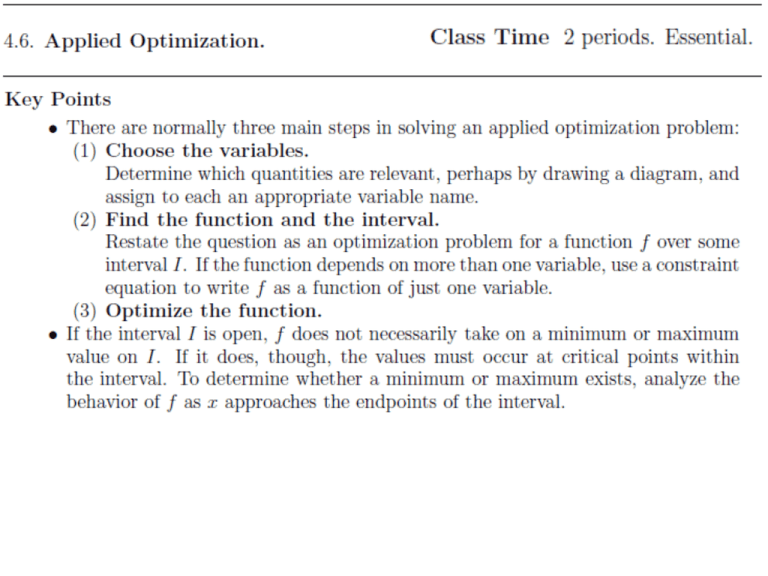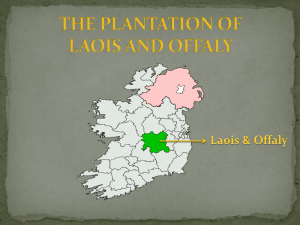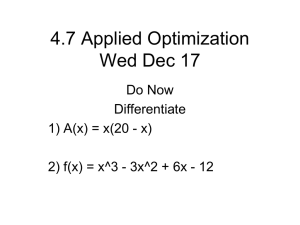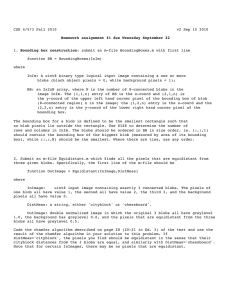r - mlgibbons
advertisement

Optimization plays a role in a wide range of disciplines, including the physical sciences, economics, and biology. For example, scientists have studied how migrating birds choose an optimal velocity v that maximizes the distance they can travel without stopping, given the energy that can be stored as body fat. In many optimization problems, the first step is to write down the objective function. This is the function whose minimum or maximum we need. Once we find the objective function, we can apply the techniques developed in this chapter. Our first examples require optimization on a closed interval [a, b]. Let’s recall the steps for finding extrema developed in Section 4.2: (i) Find the critical points of f (x) in [a, b]. (ii) Evaluate f (x) at the critical points and the endpoints a and b. (iii) The largest and smallest values are the extreme values of f (x) on [a, b]. A piece of wire of length L is bent into the shape of a rectangle. Which dimensions produce the rectangle of maximum area? y O bjective Function: S econdary Function PR ectangle L 2 x 2 y U se the S econdary Function to w rite the O bjective Fun c t i on in term s of one vari able. 1 1 2 A x x L x Lx x 2 2 R eal D o m a in: x0 & L x0 x 2 0 x L 2 L W e need t o 2 L optim i ze area o n 0 , . 2 A piece of wire of length L is bent into the shape of a rectangle. Which dimensions produce the rectangle of maximum area? y L M axim ize A x L x x on 0, 2 2 1 L A ' x L 2 x 0 x is a critical poin t 2 4 L L A '' 2 x is the location of a m ax 4 4 1 2 m ax area occurs w ith a square, such tha t s L 4 . Minimizing Travel Time Your task is to build a road joining a ranch to a highway that enables drivers to reach the city in the shortest time. How should this be done if the speed limit is 60 km/h on the road and 110 km/h on the highway? The perpendicular distance from the ranch to the highway is 30 km, and the city is 50 km down the highway This problem is more complicated than the previous one, so we’ll analyze it in three steps. You can follow these steps to solve other T x optimization problems. 30 x 2 60 2 50 x 110 , x in 0,50 Step 1. Choose variables. Step 2. Find the objective function and the interval. d T x ? d vt t v Step 3. Optimize. Minimizing Travel Time Your task is to build a road joining a ranch to a highway that enables drivers to reach the city in the shortest time. How should this be done if the speed limit is 60 km/h on the road and 110 km/h on the highway? The perpendicular distance from the ranch to the highway is 30 km, and the city is 50 km down the highway. 30 x 2 T x T x 2 50 x 60 110 1 900 x 60 T ' x 2 1/ 2 11 1 2 x 120 900 x , x in 0,50 5 2 1/ 2 1 19.5237 0.874 h x 110 x 60 900 x 2 2 x 19.5237 2 0.972 h 50 110 x 60 900 x 11 x 6 900 x 121 x 36 900 x 0.955 h 0 110 1 T x x 2 1 0 110 2 85 x 32, 400 2 x 19.524 km Optimal Price All units in a 30-unit apartment building are rented out when the monthly rent is set at r = $1000/month. A survey reveals that one unit becomes vacant with each $40 increase in rent. Suppose that each occupied unit costs $120/month in maintenance. Which rent r maximizes monthly profit? Step 1. Choose variables. O ptim ize P r w hich depends on N r , N # of units. Step 2. Find the objective function and the interval. Since one unit becomes vacant with each $40 increase in rent above $1000, we find that (r − 1000)/40 units are vacant when r > 1000. N r 30 r 1000 40 55 1 r 40 N 220 0 0 1000 r 2 2 00 1 P r N r r 120 5 5 r r 120 40 55 r 6600 1 40 r 3r P r 2 1 40 r 58 r 6 6 0 0 2 Step 3. Optimize. Optimal Price All units in a 30-unit apartment building are rented out when the monthly rent is set at r = $1000/month. A survey reveals that one unit becomes vacant with each $40 increase in rent. Suppose that each occupied unit costs $120/month in maintenance. Which rent r maximizes monthly profit? P r P ' r 1 40 1 20 r 58 r 6600 2 1000 r 2200 r 58 0 r 1 1 6 0 r P r 1000 $26, 400 1160 $27, 040 the rent w ill be $1160 Design a cylindrical can of volume 900 cm3 so that it uses the least amount of metal. In other words, minimize the surface area of the can (including its top and bottom). V ariables are clearly defined! Step 2. Find the objective function and the interval. A r , h 2 r 2 rh 2 V r , h r h 900 h 2 900 r 90 0 2 2 1 A r 2 r 2 r 2 r 1 80 0 r 2 r 2 r 0 W e'll m inim ize A r on A ' r 4 r 45 0 r 1800 r 2 1/ 3 cm 0 4 r 0, 1800 Step 3. Optimize. r 3 1800 450 r 4 A (r) → ∞ as r → ∞ (because of the r2 term) A (r) → ∞ as r → 0 (because of the 1/r term) h 10.464 cm 2 A r m ust take on a m inim um value at the critical point. Optimization Problem with No Solution Is it possible to design a cylinder of volume 900 cm3 with the largest possible surface area? A r 2 r 1800 r 2 1 N o... this function has no m ax. r A (r) → ∞ as r → ∞ (because of the r2 term) A (r) → ∞ as r → 0 (because of the 1/r term) r 0 The Principle of Least Distance states that a light beam reflected in a mirror travels along the shortest path. More precisely, a beam traveling from A to B, is reflected at the point P for which the path APB has minimum length. In the next example, we show that this minimum occurs when the angle of incidence is equal to the angle of reflection, that is, θ1 = θ2. Show that if P is the point for which the path APB has minimal length, then θ1 = θ2. our interval is open f x AP BC L x h2 2 2 x h1 2 2 f x tends to as x f x takes on its m inim um value at a critic al point x . f ' x x 2 1 x 2 x h1 1 / 2 L x 2 2 2x Lx 2 x 2 h1 x h1 2 2 L x 2 1 0 h1 2 Lx L x h1 2 cos 1 cos 2 1 2 2 2 h1 2 1 / 2 2 L x 1 CONCEPTUAL INSIGHT The examples in this section were selected because they lead to optimization problems where the min or max occurs at a critical point. Often, the critical point represents the best compromise between “competing factors.” In Example 3, we maximized profit by finding the best compromise between raising the rent and keeping the apartment units occupied. In Example 4, our solution minimizes surface area by finding the best compromise between height and width. In daily life, however, we often encounter endpoint rather than critical point solutions. For example, to run 10 meters in minimal time, you should run as fast as you can—the solution is not a critical point but rather an endpoint (your maximum speed).










